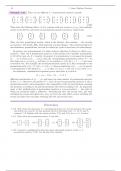Summary
Summary APPLIED LINEAR ALGEBRA
- Module
- Institution
Example 1.10. There are six different 3 × 3 permutation matrices, namely ⎛ ⎝ 1 0 0 0 1 0 0 0 1 ⎞ ⎠, ⎛ ⎝ 0 1 0 0 0 1 1 0 0 ⎞ ⎠, ⎛ ⎝ 0 0 1 1 0 0 0 1 0 ⎞ ⎠, ⎛ ⎝ 0 1 0 1 0 0 0 0 1 ⎞ ⎠, ⎛ ⎝ 0 0 1 0 1 0 1 0 0 ⎞ ⎠, ⎛ ⎝ 1 0 ...
[Show more]



